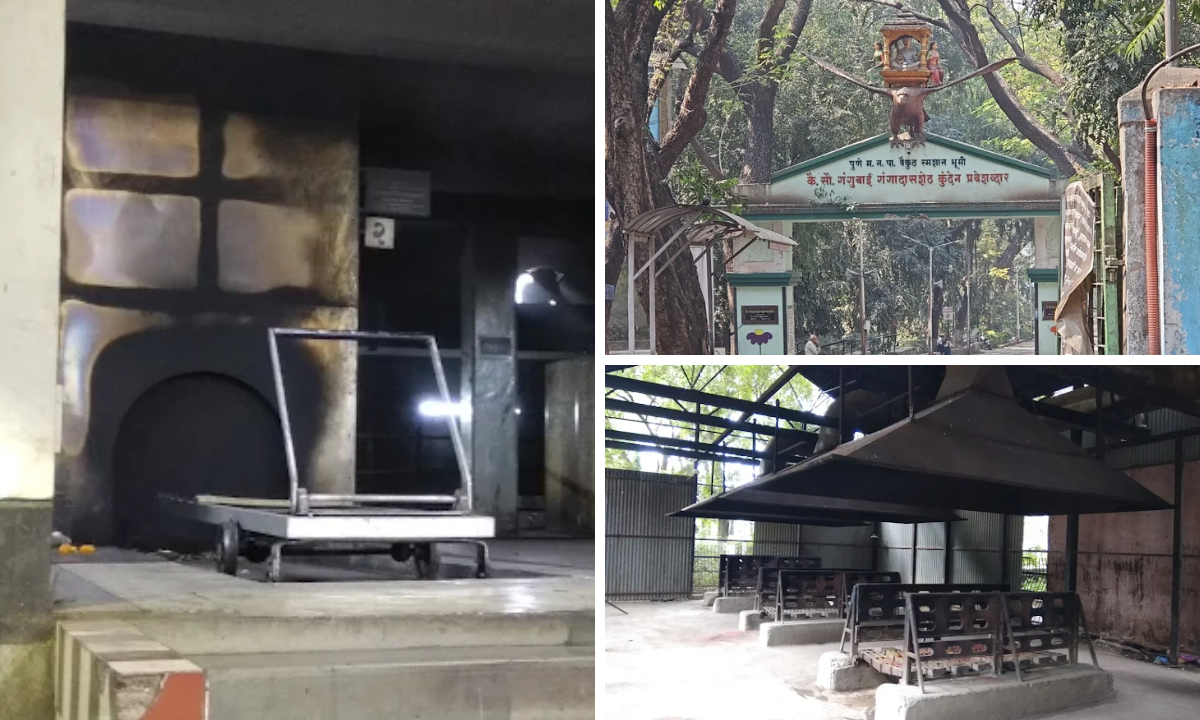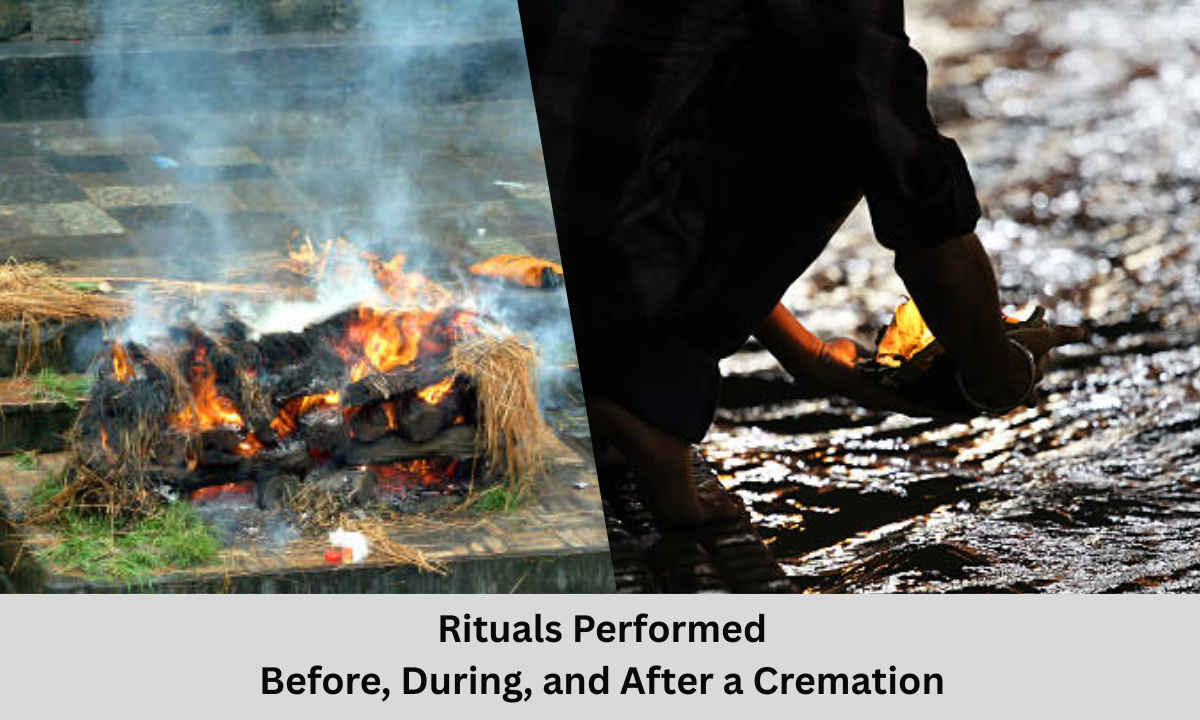At Kaashimukthi, we believe that Hindu cremation rituals are not just customs; they are sacred farewells. They are expressions of love, respect, and a deep spiritual connection with the departed soul. Through this guide, we wish to share the important steps that take place before, during, and after a cremation, ensuring every moment is handled with dignity.
Before the Cremation
1. Preparing the Body
- The journey begins with cleansing the body.
- We bathe the deceased in clean water, often with gangajal or water from other holy rivers.
- This step signifies purification before the final rites and is central to traditional cremation practices.
2. Dressing and Adorning
- After bathing, we dress the body in fresh, simple attire, usually white for men and lighter shades for women.
- Family members may choose to add flowers, garlands, or sandalwood paste to honour their loved one.
3. Placing Sacred Items
- We help families place sacred items such as tulsi leaves, sacred ash, or rice near the mouth or heart.
- These death rituals are believed to bring spiritual peace and guide the soul on its onward journey.
4. Tying the Toes and Shrouding
- As part of age-old customs, we tie the big toes together with a cotton thread.
- The body is then wrapped in a clean white shroud, symbolising peace and detachment from worldly life.
5. Arranging the Funeral Procession
- We arrange for the respectful transfer of the body to the chosen crematorium in Pune.
- In some traditions, the body is placed on a bamboo bier (arthi) and carried on the shoulders, with loved ones chanting Ram Naam Satya Hai.
During the Cremation
6. Arrival at the Crematorium

- We coordinate the booking and preparation at the selected cremation ground.
- Families in Pune often choose Vaikunth Smashanbhumi in Navi Peth or Amardham Smashan Bhumi in Hadapsar for their well-maintained facilities and respectful environment.
- Vaikunth Smashanbhumi is known for its spacious grounds and offers both open-pyre and eco-friendly CNG cremation.
- Amardham Smashan Bhumi provides options for both traditional cremation and electric cremation, along with priest services and full support.
7. Circumambulation of the Pyre
- Once at the crematorium, the chief mourner, usually the eldest son or a close male relative, walks around the pyre or electric cremation platform counterclockwise.
- This act signifies the family’s final farewell and acceptance of the soul’s departure.
8. Lighting the Pyre or Starting the Electric Cremation
- In traditional cremation, the chief mourner performs mukhagni, lighting the pyre to begin the transformation from physical form to ash.
- For electric cremation, we assist in operating the furnace or chamber, providing a faster and more environmentally friendly option.
9. Kapal Kriya (Skull Ritual)
- In some traditions, the chief mourner performs kapal kriya, a symbolic act of breaking the skull to release the soul from the earthly body.
- While not practiced by all families, it remains a deeply significant step for many communities.
10. Prayers and Mantras
- During the cremation, priests or family members chant mantras and prayers, asking for the soul’s peaceful passage.
- These prayers are an integral part of Hindu cremation rituals, offering spiritual comfort to both the departed and the bereaved.
After the Cremation
11. Cooling Period and Ash Collection
- The cremation process, whether traditional or electric, is followed by a cooling period.
- We then collect the ashes (asthi) carefully, placing them in an urn for the family.
- This moment is often emotional, as it marks the physical conclusion of the farewell.
12. Asthi Visarjan (Immersion of Ashes)
- We guide families in performing asthi visarjan, the immersion of ashes in a holy river.
- In Pune, some choose the Mula-Mutha river, while others travel to sacred locations like Haridwar or Nashik.
- This ritual signifies the final return of the body’s elements to nature.
13. Post-Cremation Death Rituals
- The days following the cremation are marked by important death rituals such as shraddha and pind daan.
- We assist in arranging these ceremonies, ensuring that the customs of each family’s tradition are respected.
14. Mourning Period and Prayer Meetings
- Many families observe a mourning period of 10 to 13 days, during which they refrain from celebrations and focus on prayer.
- We help organize prayer meetings or bhajans in memory of the departed, allowing friends and relatives to pay their respects.
The Significance of These Cremation Traditions
Each step in the cremation process carries deep cultural, emotional, and spiritual meaning. They are not mere formalities; they are acts of love that connect generations and preserve the essence of our traditions. At Kaashimukthi, we see Hindu cremation rituals as both a duty and a privilege to perform with utmost care. They provide comfort to grieving families while honoring the life and memory of the departed.
Traditional Cremation vs. Electric Cremation
Traditional cremation using a wood pyre is deeply symbolic, representing the soul’s journey through the five elements: earth, fire, water, air, and space.
However, many families today opt for electric cremation because it is faster, more cost-effective, and environmentally sustainable.
We respect every family’s choice, offering both options with the same level of dignity and compassion.
Our Role in Cremation Services in Pune
From arranging priests and sacred items to handling paperwork and booking the crematorium in Pune, we manage every aspect.
We regularly serve at Vaikunth Smashanbhumi and Amardham Smashan Bhumi, in Hadapsar, ensuring the facilities meet your needs and your loved one’s journey is conducted respectfully.
Our cremation services in Pune are designed to lift the burden off grieving families, allowing them to focus on prayers and remembrance.
Frequently Asked Questions
1. What are the main Hindu cremation rituals?
Hindu cremation rituals usually involve bathing and dressing the body, placing sacred items, performing the funeral procession, lighting the pyre (mukhagni), and post-cremation rites like asthi visarjan and shraddha.
2. Which crematoriums in Pune are best for traditional and electric cremation?
In Pune, Vaikunth Smashanbhumi and Amardham Smashan Bhumi are among the most respected crematoriums. Both provide facilities for traditional cremation and electric cremation with dignity and proper arrangements.
3. How long does the cremation process take?
A traditional cremation using a wood pyre generally takes 3–4 hours.
An electric cremation is faster, taking around 60–90 minutes depending on the facility and body size.
4. What is the difference between traditional cremation and electric cremation?
Traditional cremation follows age-old customs using a wood pyre and open flames, symbolizing the body’s return to nature.
Electric cremation uses a furnace or CNG chamber, making it quicker and more eco-friendly.
5. Who performs the last rites in Hindu cremation?
The eldest son or a close male relative usually performs the last rites, including lighting the pyre or starting the electric cremation.
These death rituals are considered sacred duties in Hindu tradition.
In Closing
Saying goodbye is never easy. But through these sacred steps, before, during, and after cremation, we ensure that farewell is filled with respect, love, and tradition.
At Kaashimukthi, we stand beside you, guiding you through each ritual so your loved one’s final journey is dignified and complete. If you need compassionate, professional cremation services in Pune, our team is here to help you every step of the way.

Madhu is an Entrepreneur, a Mentor, a Writer and an Aspiring Car Race Driver. He is Deeply passionate about leveraging Technology and Human Centred Design to make complex care and End of Life Planning easier. With the ultimate aim of Improving the quality of Life in the Twilight years. Madhu is highly educated and Alumni of IIM-Bangalore, Sikkim Manipal University and Bangalore University besides a Rich Industry Experience in the field of Product Management, Design, Supply chain, Finance, Commercial Management and Funeral Services.

